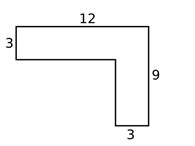In a 30-60-90 triangle, the sides are in a specific ratio. The shortest side (opposite the 30-degree angle) is half the length of the hypotenuse. So, if the hypotenuse is 6, the length of the shortest side is 6 ÷ 2 = 3.
The area of a circle is calculated using the formula A = πr^2, where r is the radius. In this case, the diameter is 16, so the radius is half of that, which is 8. Therefore, the area is 64π.

The perimeter of a shape is like the total distance you would walk around it. To find the perimeter of a shape with missing side lengths, figure out those missing lengths first. For example, if you have a side missing, and you know the other sides are 3 and 9, the missing side would be 6 to make the total 9 when added together. Then, simply add all the side lengths to get the perimeter. In this case, it would be 12 + 3 + 9 + 9 + 6 + 3 = 42.
In a triangle, the sum of all three angles is always 180 degrees. So, to find the missing angle, we can subtract the two given angles from 180 degrees. In this case, 180 - 95 - 35 = 50. Therefore, the missing angle is 50 degrees.
To find the radius of the circle, use the formula C = 2πr, where C is the circumference and r is the radius. Substitute the given circumference (30) into the formula and solve for r, which is 15. Then, to find the area, use the formula A = πr^2, and substitute the length of the radius (15) into the formula to get the area as 225 square units.
The sum of the measures of the interior angles of any polygon with n sides is given by the formula (n - 2) * 180°. Since a hexagon has six sides (n = 6), substitute 6 into the formula and calculate to get a sum of 720° for the measures of its interior angles.
To find the area of a triangle, use the formula: Area = (1/2) * base * height. In the given figure, the base is 8 units and the height is 5 units. Substitute these values into the formula and calculate the area, which will be 20 square units.
Advertisement
In a parallelogram, adjacent angles add up to 180°. Set up an equation by adding the expressions for the adjacent angles (4x + 12) and (3x + 14) and equate it to 180. Simplify the equation to find x, which turns out to be 22.
The Pythagorean Theorem states that in a right triangle, the square of the hypotenuse (the longest side) is equal to the sum of the squares of the other two sides. Only the side lengths 9, 12, and 15 satisfy this condition.
The triangle is equilateral, so its angles are 60°. The line AX bisects the angle BAC, creating two congruent angles of 30° each. Thus, the two smaller triangles are 30-60-90 triangles with a ratio of side lengths 1:√3:2. For the given figure, the base is 6 and the height is 3, so we use the area formula (1/2) * base * height to find the area.
The section of a circle that is cut off by a chord is called a segment. The segment is bounded by the chord and the arc of the circle intercepted by the chord.
A line that makes contact with a circle at one point on the circle is called a tangent. The tangent line is perpendicular to the radius of the circle at the point of contact.
The diameter of a circle is a straight line segment that passes through the center of the circle and connects two points on the circumference, dividing the circle into two equal halves. It is the longest chord in the circle, and its length is twice the length of the radius.
In geometry, the radius is the distance from the center of a circle or sphere to any point on the circumference or surface, respectively. For a circle, the radius is always the same length from the center to any point on the circle's edge. It is half of the diameter of the circle or sphere.
Advertisement
The term used to describe the distance around a rectangle is called its "perimeter," while the distance around a circle is referred to as its "circumference."
Collinear points are points that lie on the same line. In geometry, a line is a one-dimensional figure that extends without end in both directions. When points are collinear, it means they all lie on the same line. Since a line is a two-dimensional object, the collinear points also lie in the same plane. A plane is a two-dimensional flat surface that extends without end. Therefore, option A is the correct answer.